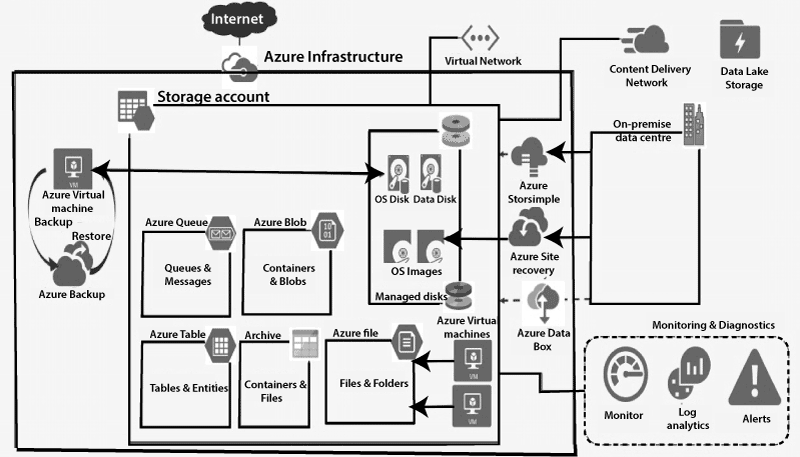87
Azure Storage Building Blocks
The fundamental building block of Azure storage service is the Azure storage account. The Storage account is more like an administrative container for most of the Azure storage services. All the storage services are explained below.
- Azure Blob: We can have Azure Blob storage within the storage account, which is used to store the unstructured data such as media files, documents, etc.

- Azure file: Azure file can be used in case if we want to share files between two virtual machines, then we can create an Azure file share and access it on both of the virtual machines. We can share the data between two or more VMs.
- Archive: Archive is recently introduced, and it is in preview. We can use the archive for cost optimization. So, we can move any infrequently accessed blobs or files into the archive to optimize the cost. However, once you move the data into an archive, it will take some time for the recovery of that data.
- Azure Queues: It can be used to store messages.
- Azure Table: It can be used to store entities. The Azure Table is a bit different from the SQL table. This is a NoSQL datastore where the schema within the table is not enforced.
And apart from all these services, there is one other key service which is:
- Azure Disk Storage: Any OS disk associated with the virtual machine in Azure will get stored in a disk storage account. And also, any OS image from which this OS disk is generated will get stored as a .vhd file within the disk storage.
- Azure Storsimple: In a hybrid cloud storage solution, Azure offers Storsimple. Storsimple is a hybrid storage solution that works at a SAN(Storage Area Network) level. It was used to be a separate company, but Microsoft brought it with them and is now offering the same services as a part of Azure and from DR (Disaster Recovery) perspective.
- Azure Site Recovery: In case if we want to use Azure as a DR data-center, then we can use Azure site recovery to replicate the workloads from our on-premises data-center into Azure. Replicated workloads will be stored as images within a storage account. Whenever our on-premises data-center is down, we can run some automated scripts which will consider that recent image and build a virtual machine.
- Azure Data Box: If we have terabytes of data which we want to transfer from the on-premises data center into Azure and we don’t want to choose a network as an option because transferring the data over the network in terms of terabytes is not feasible. So, in that case, we can use the Azure data box. By using Azure Data Box, we can load the data into the data box and give that data box to Microsoft. Microsoft will load that data into Azure
- Azure Backup: We can use Azure backup to backup the disks of our virtual machine into a recovery service vault and restore the same using that image. We have to be aware that Azure backup doesn’t utilize storage to store the disk image. They are stored in the recovery services vault.
- Azure Monitor: It can be used for the monitoring of all these services. We can use Azure Monitor for simple monitoring, and we can use log analytics for advance monitoring and analysis. We can also use alerts in case if we want to get alerted on certain things, for example, if the file share capacity is reaching its limit, then we configure it in such a way that we will get alert about the same.
- CDN (Content Delivery Network): It is used for the delivery of the contents stored in the storage account. We can use a content delivery network to reduce the latency of the delivery. We’ll create a CDN endpoint near to the users to reduce the latency.
Finally, the storage account will be connected to Virtual Network. The storage account will have a storage firewall where we can configure that from which virtual network you want to accept connections. So we can specify a particular IP address from where we want to allow connections or a specific subnet within a virtual network.
Next TopicAzure Storage Account
